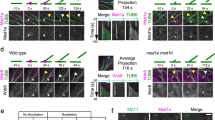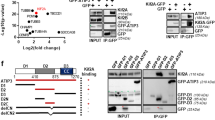Abstract
Saccharomyces cerevisiae ATS1 (α-tubulin suppressor 1) was originally identified as a high-copy suppressor of class two α-tubulin mutations and was proposed to have a regulatory role in coordinating the microtubule state with the cell cycle. Here, we show that Ats1p interacts with Nap1p, a cytoplasmic protein that regulates the activity of the Cdc28p/Clb2p complex. Loss of Nap1p results in a delayed switch from polar to isotropic bud growth. The delayed switch results in elongated buds. Nap1p and Ats1p interact in two-hybrid and co-immunoprecipitation assays. Both nap1Δ and ats1Δ cells have a Clb2p-dependent elongated bud morphology. Deletion of ATS1 partially suppresses the elongated bud morphology and benomyl resistance of nap1Δ mutants. Our results suggest Ats1p might regulate coordination of the microtubule state with the cell cycle through an interaction with Nap1p.






Similar content being viewed by others
References
Altman R, Kellogg D (1997) Control of mitotic events by Nap1 and the Gin4 kinase. J Cell Biol 138:119–130
Atkin AL, Altamura N, Leeds P, Culbertson MR (1995) The majority of yeast UPF1 co-localizes with polyribosomes in the cytoplasm. Mol Biol Cell 6:611–625
Benton BK, Tinkelenberg AH, Jean D, Plump SD, Cross FR (1993) Genetic analysis of Cln/Cdc28 regulation of cell morphogenesis in budding yeast. EMBO J 12:5267–5275
Benton BK, Tinkelenberg A, Gonzalez I, Cross FR (1997) Cla4p, a Saccharomyces cerevisiae Cdc42p-activated kinase involved in cytokinesis, is activated at mitosis. Mol Cell Biol 17:5067-5076
Brown T (1993a) Analysis of DNA sequences by blotting and hybridization. In: Ausubel FM, et al (eds) Current protocols in molecular biology. Wiley, New York, pp 2.9.1–2.9.15
Brown T (1993b) Hybridization analysis of DNA blots. In: Ausubel FM, et al (eds) Current protocols in molecular biology. Wiley, New York, pp 2.10.11–12.10.16
Chopra R, Sharma VM, Ganesan K (1999) Elevated growth of Saccharomyces cerevisiae ATH1 null mutants on glucose is an artifact of nonmatching auxotrophies of mutant and reference strains. Appl Environ Microbiol 65:2267–2268
Cvrckova F, Nasmyth K (1993) Yeast G1 cyclins CLN1 and CLN2 and a GAP-like protein have a role in bud formation. EMBO J 12:5277–5286
Cvrckova F, De Virgilio C, Manser E, Pringle JR, Nasmyth K (1995) Ste20-like protein kinases are required for normal localization of cell growth and for cytokinesis in budding yeast. Genes Dev 9:1817–1830
Elion EA (1999) Detection of protein–protein interactions by coprecipitation. In: Ausubel FM, et al (eds) Current protocols in molecular biology. Wiley, New York, pp 20.25.21–20.25.29
Farkas V, Kovarik J, Kosinova A, Bauer S (1974) Autoradiographic study of mannan incorporation into the growing cell walls of Saccharomyces cerevisiae. J Bacteriol 117:265–269
Fichtner L, Schaffrath R (2002) KTI11 and KTI13, Saccharomyces cerevisiae genes controlling sensitivity to G1 arrest induced by Kluyveromyces lactis zymocin. Mol Microbiol 44:865–875
Fitch I, et al (1992) Characterization of four B-type cyclin genes of the budding yeast Saccharomyces cerevisiae. Mol Biol Cell 3:805–818
Gietz DR, Wood RA (1998) Transformation of yeast by the lithium acetate/single-stranded carrier DNA/PEG method. Academic Press, San Diego, Calif.
Ishimi Y, Kikuchi A (1991) Identification and molecular cloning of yeast homolog of nucleosome assembly protein I which facilitates nucleosome assembly in vitro. J Biol Chem 266:7025–7029
Iwase M, Toh-e A (2001) Nis1 encoded by YNL078 W: a new neck protein of Saccharomyces cerevisiae. Genes Genet Syst 76:335–343
James P, Halladay J, Craig EA (1996) Genomic libraries and a host strain designed for highly efficient two-hybrid selection in yeast. Genetics 144:1425–1436
Kellogg DR, Murray AW (1995) NAP1 acts with Clb2 to perform mitotic functions and to suppress polar bud growth in budding yeast. J Cell Biol 130:675–685
Kellogg DR, Kikuchi A, Fujii-Nakata T, Turck CW, Murray AW (1995) Members of the NAP/SET family of proteins interact specifically with B-type cyclins. J Cell Biol 130:661–673
Kirkpatrick D, Solomon F (1994) Overexpression of yeast homologs of the mammalian checkpoint gene RCC1 suppresses the class of alpha-tubulin mutations that arrest with excess microtubules. Genetics 137:381–392
Lew DJ, Reed SI (1993) Morphogenesis in the yeast cell cycle: regulation by Cdc28 and cyclins. J Cell Biol 120:1305–1320
Longtine MS, Fares H, Pringle JR (1998) Role of the yeast Gin4p protein kinase in septin assembly and the relationship between septin assembly and septin function. J Cell Biol 143:719–736
Longtine MS, Theesfeld CL, McMillan JN, Weaver E, Pringle JR, Lew DJ (2000) Septin-dependent assembly of a cell cycle-regulatory module in Saccharomyces cerevisiae. Mol Cell Biol 20:4049–4061
Lundblad V, Zhou H (1997) Manipulation of plasmids from yeast cells. In: Ausubel FM, et al (eds) Current protocols in molecular biology. Wiley, New York, pp 13.19.11–13.19.16
Moore JD (2001) The Ran-GTPase and cell cycle control. BioEssays 23:77–85
Mortensen EM, McDonald H, Yates J III, Kellogg DR (2002) Cell cycle-dependent assembly of a Gin4–septin complex. Mol Biol Cell 13:2091–2105
Richardson H, Lew DJ, Henze M, Sugimoto K, Reed SI (1992) Cyclin-B homologs in Saccharomyces cerevisiae function in S phase and in G2. Genes Dev 6:2021–2034
Shimizu Y, Akashi T, Okuda A, Kikuchi A, Fukui K (2000) NBP1 (Nap1 binding protein 1), an essential gene for G2/M transition of Saccharomyces cerevisiae, encodes a protein of distinct sub-nuclear localization. Gene 246:395–404
Tjandra H, Compton J, Kellogg D (1998) Control of mitotic events by the Cdc42 GTPase, the Clb2 cyclin and a member of the PAK kinase family. Curr Biol 8:991–1000
Tong AH, et al (2001) Systematic genetic analysis with ordered arrays of yeast deletion mutants. Science 294:2364–2368
Treco DA, Winston F (1998) Growth and manipulation of yeast. In: Ausubel FM, et al (eds) Current protocols in molecular biology. Wiley, New York, pp 13.12.11–13.12.12
Wente SR, Rout MP, Blobel G (1992) A new family of yeast nuclear pore complex proteins. J Cell Biol 119:705–723
Zimmerman ZA, Kellogg DR (2001) The Sda1 protein is required for passage through Start. Mol Biol Cell 12:201–219
Acknowledgements
This material is based upon work supported by the National Science Foundation under grant 9874516 and a grant from the Layman Foundation. Any opinions, findings, conclusions or recommendations expressed in this material are those of the authors and do not necessarily reflect the views of the National Science Foundation or the Layman Foundation. We would like to thank Drs. Phil James, Frank Solomon, David Kirkpatrick, Doug Kellogg and Raffael Schaffrath for providing plasmids, strains, antibodies and suggestions. We thank Dr. You Zhou and Michelle Mathiesen for technical assistance with microscopy and thank Drs. Kenneth Nickerson and Jacob Hornby for their helpful advice on the growth curve and dry cell weight experiments. We would also like to thank Drs. Steve Harris, Cathy Chia, Larry Harshman and John Osterman and members of the Atkin Laboratory for their critical reading and helpful suggestions during preparation of the manuscript.
Author information
Authors and Affiliations
Corresponding author
Additional information
Communicated by S. Hohmann
Rights and permissions
About this article
Cite this article
Shields, C.M., Taylor, R., Nazarenus, T. et al. Saccharomyces cerevisiae Ats1p interacts with Nap1p, a cytoplasmic protein that controls bud morphogenesis. Curr Genet 44, 184–194 (2003). https://doi.org/10.1007/s00294-003-0442-z
Received:
Revised:
Accepted:
Published:
Issue Date:
DOI: https://doi.org/10.1007/s00294-003-0442-z




